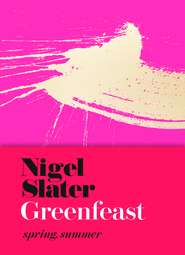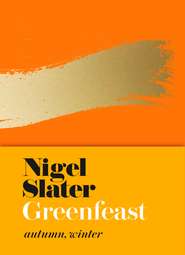По всем вопросам обращайтесь на: info@litportal.ru
(©) 2003-2024.
✖
The Kitchen Diaries II
Настройки чтения
Размер шрифта
Высота строк
Поля
butter: a thick slice, about 25g
smoked bacon: 120g
celeriac: 800g (1 large root)
thyme: the leaves from 3 small sprigs
chicken or vegetable stock: 500ml
water: 1 litre
grain mustard: 4 teaspoons
parsley: a small bunch
Peel the onions and roughly chop them. Melt the butter in a large, heavy-based saucepan and add the onions. Let them cook for ten to fifteen minutes or so, till translucent. As they cook, cut the bacon into short strips or dice and add them to the pan. Leave over a moderate heat, stirring occasionally, till the bacon fat is pale gold and the onions are soft.
While the onions and bacon are cooking, peel and coarsely grate the celeriac. Stir it into the onions, add the thyme leaves and a little salt, then pour in the stock and water. Bring to the boil, lower the heat and cover with a lid. Leave to simmer for thirty minutes, then stir in the mustard. Chop the parsley and add it to the soup with a seasoning of salt and black pepper. Simmer for five minutes, then remove from the heat.
Remove half the soup and blitz in a blender or food processor till almost smooth. You may need to do this in several batches, so as not to overfill the blender jug. Return the liquidised soup to the remaining soup in the saucepan. You will probably find the result is creamy enough, but if you wish to add some cream, then this is the point at which to do it. Check the seasoning and serve.
Enough for 6
JANUARY 2
A bunch of parsley
Few herbs have much to offer in winter, save bay. Even that is more aromatic when it is dried. They need the heat of the sun to concentrate the aromatic oils that lurk in their leaves and, sometimes, their stems. Parsley, though, has plenty of flavour even in the dead of winter, unless it has frozen in the ground. Parsley heals (John Gerard, the sixteenth-century herbalist, used it to quell stomach complaints) and has a high vitamin C content. Where basil stirs the senses, parsley brings us back to earth.
There is much talk about parsley stems and where they are useful. I don’t mind them in a leaf salad if they are fine and young, no thicker than a needle, but I don’t include them in ‘chopped parsley’, rough or otherwise. The stem occasionally carries an inherent bitterness and can be string-like too. Fastidiously stripping the leaves from their stems is something worth doing.
The stalks add a pleasing mineral quality to stock and soup (they possess a long tap root, like horseradish, that can stretch a foot or more into the earth) but you might prefer to add them towards the end of cooking, otherwise they will introduce a cabbagy note. Twenty minutes is time enough.
Wasted in its usual role as a garnish, if not downright pointless, this biennial, slow-germinating herb prefers rich soil, ideally slightly alkaline. Liking a little shade and winter shelter, it does well in my dampest bed, under the medlar tree. You can grow it from seed if you have the patience. I ‘rescue’ large pots of it from the supermarket and plant it in the garden just as others rescue battery hens.
There is little of interest in the cupboards and the fridge is as bare as I have seen it. But there is a granite-like lump of Parmesan in an airtight box in the fridge, a packet of rice in the cupboard and therefore the possibility of risotto. Parsley makes a surprisingly luxurious addition to rice as long as you are generous with the butter and cheese.
A parsley risotto with Parmesan crisps
Timing wise, you can manage to give the risotto its last ladle of stock, then start on the crisps. They will stay warm and crisp(ish) for long enough.
flat-leaf parsley: a good 50g
hot stock (chicken, turkey, vegetable at a push): a litre
a shallot or very small onion
butter: a thick slice
Arborio rice: 300g
a small glass of white wine or vermouth
To finish:
butter and grated Parmesan
For the Parmesan crisps:
finely grated Parmesan: 4 heaped tablespoons
Prepare the parsley. Pull the leaves from their stems, crack the stems with the back of a knife – their mineral scent is worth inhaling – then put them in a pan with the stock and bring to the boil. As the stock boils, turn the heat down to a low simmer. Finely chop the parsley leaves.
Peel and very finely chop the shallot and let it cook in the butter in a saucepan, without taking on any colour. Add the rice, turn the grains briefly in the butter till glossy, then pour in the wine and let it cook for a minute or two. Add a ladle of the stock. Stirring almost constantly, add another ladle of stock and continue to stir until the rice has soaked it all up. Now add the remaining stock, a ladle at a time, stirring pretty much all the time till the rice has soaked up the stock, the grains are plump and the texture creamy.
Stir in the chopped parsley, a thick slice of butter and a couple of handfuls of grated Parmesan. Season carefully.
For the Parmesan crisps, simply put heaped tablespoons of the grated Parmesan into a warm, non-stick frying pan. Press the cheese down flat with a palette knife and leave to melt. As soon as it has melted, turn once and continue cooking for a minute or so. Lift off with the palette knife and cool briefly. They will probably crisp up in seconds. Place on top of the risotto and serve.
Enough for 4
JANUARY 3
A crisp salad for a winter’s day
There are some pears and cheese left from Christmas, a couple of heads of crisp, hardy salad leaves still in fine fettle, and a plastic box of assorted sprouted seeds in the fridge. I put them together almost in desperation, yet what results is a salad that is both refreshing and uplifting, clean tasting and bright.
A salad of pears and cheese with sprouted seeds
Crisp, mild, light and fresh, this is the antidote to the big-flavoured salad. I prefer to use hard, glassy-fleshed pears straight from the fridge for this, rather than the usual ripe ones. Any sprouted seeds can be used, such as radish seeds, sunflower or mung beans. The easy-to-find bags of mixed sprouts are good here, too. The cheese is up to you. Something with a deep, fruity flavour is probably best, though I have used firm goat’s cheeses on occasion too. Rather than slicing it thickly, I remove shavings from the cheese with a vegetable peeler. A sort of contemporary ploughman’s lunch.
crisp pears: 2
bitter leaves such as frisée or trevise: 4 handfuls
firm, fruity cheese such as Berkswell: 150g
assorted sprouts (radish, alfalfa, sunflower, amaranth, etc.): a couple of handfuls
For the dressing:
natural yoghurt: 150ml
olive oil: 2 tablespoons
herbs, such as chervil, parsley, chives: a handful
Put the yoghurt into a bowl and whisk in the olive oil and a little salt and black pepper. Chop the herbs and stir them into the yoghurt.











